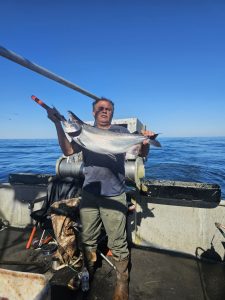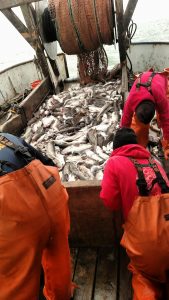From the Summer 2025 Sea Star
July 10, 2024
By Jess Davis, WSG Science Communications Fellow

Bain pulling up his catch. Photo courtesy of Roger Bain.
Growing up in Washington state and a member of the Makah Tribe, Roger Bain’s ancestral and more-recent family history might suggest that he was destined to become a fisherman. The Makah people refer to themselves as qʷidiččaʔa·tx̌, which translates approximately to “The People who live near the Rocks and the Seagulls.” Aquatic organisms are integral to the Makah way of life, and they fish everything from whales to salmon and herring. In the 20th century, Bain’s grandfather hunted seals. “It’s in the blood,” Bain says of the Makah and fishing.
When I first reached out to Bain to chat with him about his career as a fisherman, I was met with an approaching deadline. Bain expressed to me that we needed to chat, now or never, because halibut season opening day was fast approaching. He would not be available out on the water; that time is for the fish. The pressure was on–much like Bain’s introduction to commercial fishing back when he was still a boy.
When Bain was on the brink of adolescence, his parents thought that fishing could be the tool he needed to keep him out of trouble. At the age of 11, he was sent to live – and fish – with his older brother. Together, they trawled for trout and salmon: king, coho, and sockeye. Bain did not enjoy fishing much during these early days. But one fateful, chilly evening in the early 70s, he saw his brother pulling up fish and putting them in their boat. All at once, Bain was inspired to dedicate himself to learning the craft. That same night he decided to try his hand at fishing independently, unbeknownst to his brother. When Bain was caught, his brother proclaimed, “If you’re going to do it, you better do it right.” Bain’s brother began teaching him the ways of fishing. Eventually, Bain moved in with his brother permanently. He was fishing independently, and regularly, by the age of 16.
Fishing has looked different for Bain over the course of his decades long career. While he started out targeting salmon, he eventually moved on to groundfish like halibut and black cod. Fishing for groundfish was different from fishing for salmon: the primary catch mechanism is longlining instead of the gillnetting he grew up learning. There was a learning curve, but Bain pulled knowledge about longlining from his network of fellow fishermen to become successful. He was able to purchase his own boat and hire a crew to work for him. Purchasing his first boat at the young age of 24 is the event that Bain highlighted as the proudest moment of his career.
Bain’s experience fishing groundfish eventually led him to serve as the tribal representative on the Pacific Fisheries Management Council’s groundfish advisory council. Upon his appointment, it became clear that non-tribal fishermen did not understand the rules and regulations that tribal fishermen had to follow. For example, not only did Tribal fishermen have to follow the same federal regulations, but they also needed observers to collect real-time data of what was being caught and discarded onboard while fishing. Bain saw his appointment as an opportunity to “[sit] on the gap” between tribal and non-tribal fishermen’s best interests, a role he described as “positive and productive” for all parties involved.

Bain’s sons helping him out on the water. Photo courtesy of Roger Bain.
These days, Bain is back to fishing for salmon. He says that the landscape of salmon fisheries is vastly different today than it was back in the 70s and 80s. Considering this year’s World Fish Migration Day theme, the free flow of rivers, I figured that excessive damming in Washington’s rivers was partially to blame. Bain told me, “it’s more than dams.” He noted factors like nutrient pollution caused by septic systems bleeding into the water table and the population explosion of salmon predators. In 1972, the Marine Mammal Protection Act was passed into law, protecting charismatic megafauna such as seals and sea lions from being hunted or captured. This law has been largely successful for Washington and Oregon seals. Bain explained that it was typical to see one or two seals back in the 70s, but today you see thousands of them year round. “When you put it all together, it spells trouble for the salmon,” he says. Bain has noticed that salmon abundance is much lower. Back when he first started fishing, an average day’s haul looked something like 500 fish when he worked alone. Now he’s lucky to pull up 300 in a day fishing with his sons. Fish are also smaller than they were in years past.
Luckily, there are a number of salmon recovery efforts happening around Washington state. It is this kind of work that gives hope for the future of salmon in the Pacific Northwest, and could keep Bain fishing with his sons for years to come.
###
Washington Sea Grant, based at the University of Washington, helps people and marine life thrive through research, technical expertise and education supporting the responsible use and conservation of coastal ecosystems. The National Sea Grant College Program is part of the National Oceanic and Atmospheric Administration, U.S. Department of Commerce.
Join the conversation: instagram.com/waseagrant and Facebook.com/WaSeaGrant.
JUL
2024